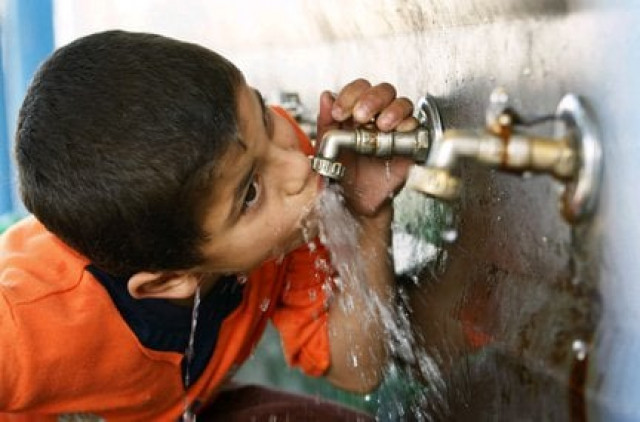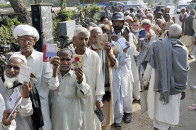69% water suppliers fail key quality test
Only 31% samples put through test found safe

A child drinking water from the tap. PHOTO: REUTERS
According to Pakistan Council of Research in Water Resources’ (PCRWR) latest survey, there has only been an increase of ten per cent in the quality of water provided for drinking since 2006.
These numbers clearly indicate that achieving Sustainable Development Goal 6 (SDG) Target 6.1 – the provision of 100 per cent clean water – will be challenging.
PCRWR’s National Water Quality Monitoring Program (NWQMP) conducted detailed testing of water in Islamabad, Bahawalpur, Faisalabad, Gujranwala, Gujrat, Kasur, Lahore, Multan, Rawalpindi, Sargodha, Sheikhupura, Sialkot, Mingora, Abbottabad, Mardan, Peshawar, Loralai, Quetta, Ziarat, Hyderabad, Karachi, Sukkur, Muzafarabad, Gilgit and Badin.
Judicial commission orders testing of water supplied to citizens in Sindh
Out of the 369 sources that were selected for testing, 114 or 31 per cent sources were found safe as opposed to 255 (69 per cent) that were not. The study showed that 57 per cent of the water samples were microbiologically contaminated, while other contaminants included arsenic (6%), turbidity (8%), chloride (15%), nitrate (6%), TDS (11%), hardness (6%) and iron (10%).
During the first water quality survey, conducted from 2002 to 2006, data had shown that 84 per cent of the samples collected were contaminated.
Contaminants were present in the following percentages: bacteria (69%), arsenic (24%), nitrate (14%) and fluoride (5%). The analytical findings were compared with standards set out by World Health Organisation.
Court orders: Commission wants water quality testing, measurement details
“Although the latest data is not promising, it is at least better than the data we collected ten years ago. We need to pick up the pace because at this rate we will never be able to provide 100 per cent clean drinking water by 2030.” a senior official from PCRWR told The Express Tribune.
He further said that Sindh had the worst of the water contamination problem, followed closely by Balochistan. The water quality was better in Khyber-Pakhtunkha and the best in Punjab, as compared to the other provinces. “Despite there being many directives to improve water quality in Sindh, the provincial government has done little to improve the situation,” said the official.
He also lamented the lack of effort and focus on the provision of clean drinking water, adding “These things require substantial infrastructure and human resources on the part of the provincial governments, as after the 18th amendment, it is their responsibility to provide citizens with good quality drinking water.”

1724926799-0/Untitled-design-(7)1724926799-0-208x130.webp)

















COMMENTS
Comments are moderated and generally will be posted if they are on-topic and not abusive.
For more information, please see our Comments FAQ